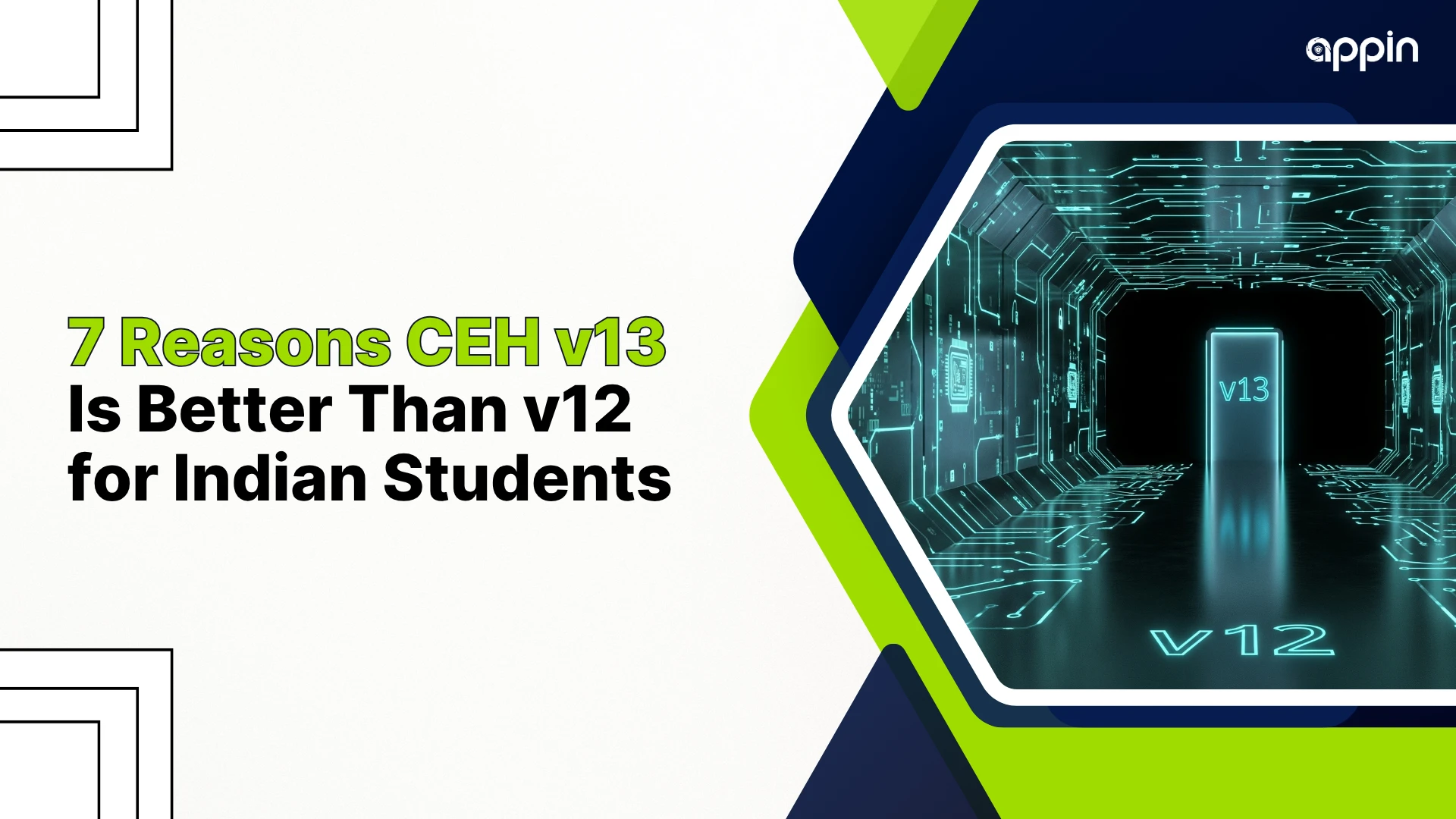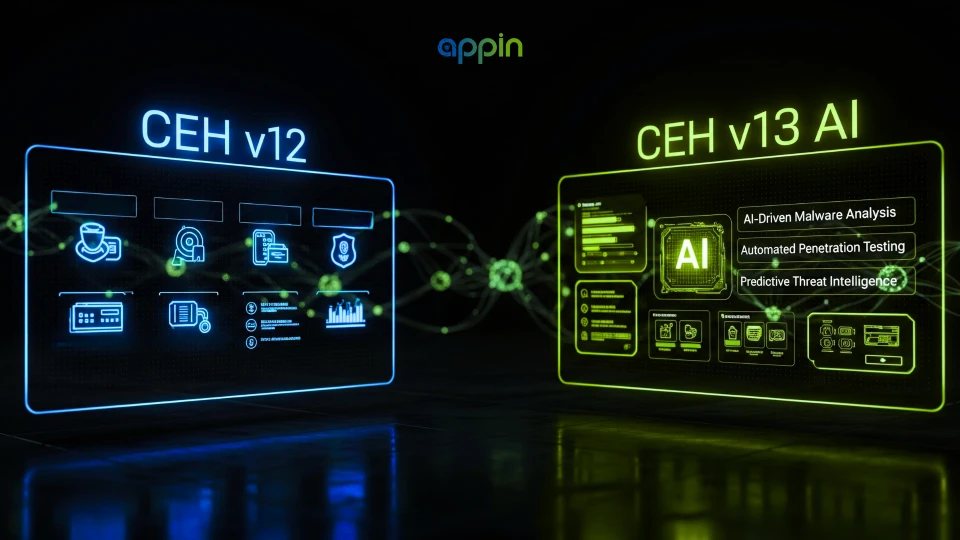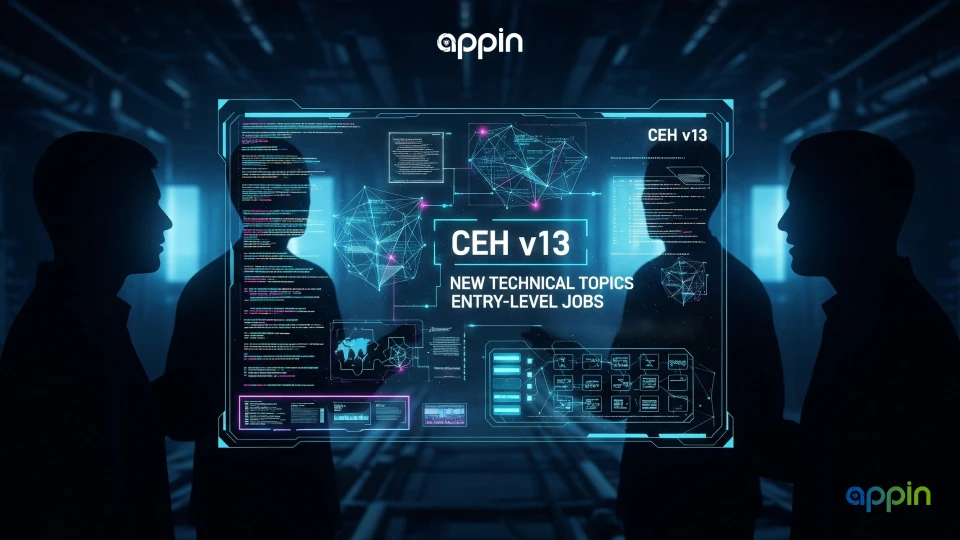Why should Indian students read this comparison of CEH v13 and CEH v12?
CEH v13 vs v12 for Indian students matters because v13 adds AI training, larger labs, and new modules that improve job readiness.
If you are a student or early career professional, this comparison shows what skills employers now expect and how the updated course maps to entry level roles.
CEH v13 brings practical lab time, AI tool practice, and a formal practical exam that together make certification more relevant for placement interviews.
Read on for seven clear reasons why CEH v13 may be the better choice for Indian students, with study tips and cost context you can use right away.
What is the single biggest difference between CEH v13 and CEH v12?
The main difference is that CEH v13 integrates AI across the curriculum, adding AI system security and OWASP guidance for AI.
CEH v13 is not just an added chapter on AI, it embeds AI concepts across reconnaissance, scanning, exploitation, and post exploitation phases. This means you learn how AI can both help attackers and defenders, and you practice techniques to find AI specific weaknesses. For students, that shift matters because many entry level roles now touch cloud services and AI-assisted tooling.
Key points to note:
- AI system security and OWASP for AI are new modules that teach how models can be attacked and protected.
- The course shows how to use AI to automate repetitive tasks, while also teaching defensive checks to detect AI assisted attacks.
- Employers value candidates who can explain AI risks and apply simple mitigations in a lab or interview.
Practical tip: while studying, keep a short notebook of AI attack techniques and defensive checks you practice in the lab. This helps you answer interview questions with examples rather than theory.
Does CEH v13 give you more practical lab experience than CEH v12?
Yes. CEH v13 expands lab coverage significantly so you get much more hands-on practice.
CEH v13 includes 221 hands-on labs and access to 4,000+ tools. That wide lab set covers modern attack chains, AI assisted reconnaissance, cloud scenarios, and common enterprise configurations you will see in entry level roles. For Indian students, more labs mean more material to cite in interviews and more confidence during practical assessments.
What to focus on in the labs:
- Reconnaissance and scanning workflows that combine manual steps with AI assisted outputs.
- Exploit validation and post exploitation checks in contained VMs.
- Cloud focused labs that show misconfigurations, identity issues, and simple remediation steps.
Study routine suggestion: schedule 2–3 hour lab blocks and log your steps. Use short notes for commands used, outcomes observed, and one improvement you would make. That habit turns lab practice into concrete examples you can discuss during placement interviews.
How do the exam and practical components in CEH v13 improve your career chances?
CEH v13 adds a structured practical exam and realistic engagement simulations that mirror employer expectations and improve placement readiness.
The certification now has both a timed knowledge exam and a six hour practical challenge set, which tests your ability to operate in a simulated network environment. These practical challenges teach you how to manage time, select tools, and document findings, skills recruiters check for in junior security roles.
Why this matters for employability:
- Practical exam experience proves you can do tasks, not just answer questions.
- Engagement simulations mirror real consulting or SOC tasks, which shortens the on job learning curve.
- Employers prefer candidates who can show a lab report or challenge write up during interviews.
Training route recommendation: choose an official training route such as the CEH v13 AI-powered course to get guided lab access, mock practicals, and placement support. When you describe your certification in applications, mention specific challenges you completed and the tools you used, not only the certificate name.
Are there AI tools in CEH v13 that help beginners learn faster?
Yes. CEH v13 integrates practical AI tools like ShellGPT and guided ChatGPT workflows to speed command generation and reconnaissance.
ShellGPT is an AI command line assistant that helps generate shell commands and scripts for Bash, PowerShell, and other shells. It saves time on syntax and lets you experiment with variants quickly. ChatGPT style workflows are taught to brainstorm attack vectors, draft security policies, and simplify complex procedure steps into checklists.
How these tools help beginners:
- Faster iteration on commands, so you spend more time understanding outputs.
- Clearer documentation templates for lab reports and findings.
- Assisted reconnaissance that points you to likely targets to test in labs.
Practical tip: use AI tools to learn variations, but always verify results in the lab. AI can suggest a command that needs modification for your exact VM environment. Log both the AI suggestion and your validated final command so you can explain what you changed and why.
Which new technical topics in CEH v13 matter most for entry-level jobs?
Modules on cloud security, IoT and OT security, and AI vulnerabilities are the most relevant new topics for entry-level roles in today’s job market.
Employers in India increasingly look for basic cloud security awareness and the ability to spot common IoT issues. CEH v13 adds targeted labs and lessons for these areas so you can demonstrate practical knowledge rather than generic familiarity.
Key new modules to highlight on your resume:
- Cloud security basics and common misconfiguration patterns.
- IoT and OT security fundamentals for simple device reconnaissance.
- AI system security and OWASP for AI specific threats.
Job matching tip: when applying for roles, map each module to the job description. For example, if a role mentions cloud security, describe a specific lab where you found a misconfigured S3 style bucket or insecure identity setting and what you did to verify and report it.
How do exam and package costs for CEH v13 compare for Indian students?
CEH v13 exam and training packages fall within expected professional certification ranges, and student friendly options through authorized training centers can lower costs.
Global exam voucher pricing sits in a higher band, while India specific packages typically range lower when bundled with training. Many authorized training centers and academic partners offer classroom or hybrid training that includes lab access and mock practicals at student rates.
Cost checklist for Indian students:
- Exam voucher only, exam retake and membership fees are separate costs.
- Instructor led or classroom packages usually include lab access and practice tests.
- Look for student or academic discounts through authorized centers to reduce total cost.
Eligibility note: official routes may allow direct training access, while the self study route often requires experience for exam eligibility. Check training center offers for instalment plans and placement assistance if budget is a concern.
How long will it take an Indian student to prepare for CEH v13 and how should they study?
A practical plan is 2–4 months of preparation, with 10–12 hours per week plus at least 100 hours of lab practice.
Study plan in brief:
- Month 1: Core modules and 40 hours of guided labs.
- Month 2: Advanced modules, AI tool practice, and 40 hours of focused labs.
- Final weeks: Mock practicals, timed challenges, and lab report practice.
Success tips: keep a lab journal, practice timed challenges, and review practical exam format regularly. This routine builds both skill and confidence.
Next steps
If you want hands-on guidance, enquire now with Appin to discuss classroom or hybrid CEH v13 training, lab access, and placement assistance. Start by listing two dates you can commit to for lab practice each week, and a short goal such as “pass practical exam” so trainers can create a focused plan for you.




